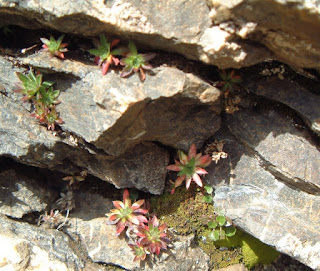
It’s cooler at the top, but not cold, and we set off in bright sunshine on a well-surfaced path. The photo shows Jane rarin’ to go set against the backdrop of a huge vista.

It’s like walking at the top of the world, and we start looking for a handy rock to sit on to eat our sandwiches and enjoy the view. It must be that all other walkers have the same thoughts at this precise point because we come across the following notice written, as are all the best notices abroad, in quaint English.

Lunch being finished, and the debris suitably deposed in our dust-pan, we continued on the path that gradually rounded a headland of rock to lead into a south-facing valley. Here there were many more alpine plants in the rock crevices, and mixtures of heather and an unidentified red-leafed shrub covering most of the open ground, looking like a Scottish glen. The next two pictures are examples.


There’s been something of a problem taking the big mountain views on this holiday. The Eiger, Mönch and Jungfrau peaks dominate the scenery. You take them from all angles, distances and weather and light combinations. Yes, they are fantastic, but soon you realise that you’ve got far too many snaps of them, and none of them is as good as the professional photos in books, brochures and on the net. People are fed up with seeing them, anyway. After all that, would you believe it, I’ve included one last one of the north face of the Eiger! It just looks as if I’m about to climb it, alpenstock in hand, and be back in time for tea. We caught the mountain train down shortly after.























